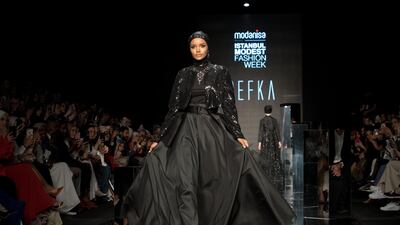In the UK, there is talk that the recession we are facing is the worst in 300 years. Brought on by the coronavirus pandemic, this year many of us cut down on consumption, due to lockdowns and lost jobs.
Most people I have spoken to have spent less on what would ordinarily be normal expenditures: eating out, travelling and yes, buying clothes.
The same applies globally, with the fashion industry, as well as travel and hospitality, experiencing major disruptions. The modest fashion market, worth $277 billion last year, also suffered losses brought on by Covid-19.
Modest fashion means women's clothing that covers most of the body – abayas, hijabs, long-sleeved tops and jackets in modest cuts. The sector has thrived for the past 20 years, driven by Muslim women who found that the high street was lacking in the kind of modest but stylish clothes they were looking for.
Whether for religious reasons or out of personal preference, modest fashion has fans across the globe. Consumers are often – but not always – a part of the global Islamic economy, made up of the world’s 1.8 billion Muslims. It includes sectors as diverse as halal meat, Islamic finance, pharmaceuticals, cosmetics, media, recreation, travel, clothes and many more.
Given its reputation as a fashion hub, it is not surprising the UAE makes up the third-largest Islamic economy and the world's biggest modest fashion market. But over the past 18 months, the market has experienced ups and downs. Ramadan in 2019 saw huge and positive developments in modest fashion, with brands such as Nike and Banana Republic engaging with the idea for the first time. 2020, however, brought much of that to a halt.
The Ramadan and Eid months are normally the biggest season for sales in my sector. As many countries were this year under lockdown during those months, modest fashion fitted the global trend of major decline in clothes sales.
But despite this year's slump, some positive developments could slowly gain momentum. While we wait for markets to return to normal and consumers to return to shops, us industry insiders, designers and brands have an opportunity to broaden the scope of modest fashion.
It is worth having a conversation about what the term "modest" could come to mean in the future, be this an emphasis on sustainable over fast fashion, or more care given over to how the industry uses resources.
Two yeas ago, Muslim fashion influencer Dina Tokio caused controversy when she stopped wearing the hijab. At the time she made her choice, she was also speaking about her changing approach to fast fashion. This included her embrace of the idea that modest fashion could focus on a reduction in consumption, as well as a departure from the temptation to keep up with trends.

There are other promising developments across the world. For example, in Indonesia and Singapore, Style Theory is a designer clothing platform for leasing modest fashion. The UK-based brand Sei Sorelle, is a full coverage swimwear company that uses waste products such as discarded fishnets and reclaimed plastic to create sustainable fabrics. This year, during Melbourne Fashion Week, a thrift market was held for modest fashion items of clothing.
All of these initiatives ought to prompt consumers interested in style and fashion to reflect on resource exploitation and biodegradability. Modest fashion consumers should also think about the supply chain of their clothes and determine whether or not manufacturers are exploiting underpaid labour in developing countries.
The biggest shift will be in what "modest" means to the industry. This week, Halima Aden, arguably the first Muslim supermodel, shared her personal journey in modelling. She became the first Muslim hijab-wearing face of many global women's magazines and for many, including Ms Aden herself, she seemed to strike a balance between upholding certain values, while being at the cutting edge of fashion. However, Ms Aden recently acknowledged that, instead of the fashion industry trying to accommodate new ideas of identity, she had to compromise her own modesty in order to fit in. Having had time to reflect during the pandemic, she said she would return to what some might describe as her more "traditional" modest fashion look.
While 2020 has caused severe losses to the industry, it has also provided an opportunity for everyone involved to think more about what modest fashion can mean, beyond just being a look or a statement of identity or belief. With conscious effort, we can shift our focus towards a more holistic, environment-friendly concept of modesty.
Shelina Janmohamed is an author and a culture columnist for The National


